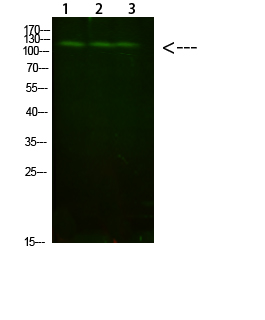FIG4 Polyclonal Antibody
- Catalog No.:YT6068
- Applications:WB;ELISA
- Reactivity:Human;Mouse
- Target:
- FIG4
- Fields:
- >>Inositol phosphate metabolism;>>Metabolic pathways;>>Amyotrophic lateral sclerosis;>>Pathways of neurodegeneration - multiple diseases
- Gene Name:
- FIG4 KIAA0274 SAC3
- Protein Name:
- FIG4
- Human Gene Id:
- 9896
- Human Swiss Prot No:
- Q92562
- Mouse Gene Id:
- 103199
- Mouse Swiss Prot No:
- Q91WF7
- Immunogen:
- Synthesized peptide derived from human FIG4. at AA range: 341-390
- Specificity:
- This antibody detects endogenous levels of FIG4
- Formulation:
- Liquid in PBS containing 50% glycerol, 0.5% BSA and 0.02% sodium azide.
- Source:
- Polyclonal, Rabbit,IgG
- Dilution:
- WB 1:500-2000, ELISA 1:10000-20000
- Purification:
- The antibody was affinity-purified from rabbit antiserum by affinity-chromatography using epitope-specific immunogen.
- Concentration:
- 1 mg/ml
- Storage Stability:
- -15°C to -25°C/1 year(Do not lower than -25°C)
- Other Name:
- Polyphosphoinositide phosphatase (EC 3.1.3.-) (Phosphatidylinositol 3,5-bisphosphate 5-phosphatase) (SAC domain-containing protein 3)
- Observed Band(KD):
- 110kD
- Background:
- The protein encoded by this gene belongs to the SAC domain-containing protein gene family. The SAC domain, approximately 400 amino acids in length and consisting of seven conserved motifs, has been shown to possess phosphoinositide phosphatase activity. The yeast homolog, Sac1p, is involved in the regulation of various phosphoinositides, and affects diverse cellular functions such as actin cytoskeleton organization, Golgi function, and maintenance of vacuole morphology. Membrane-bound phosphoinositides function as signaling molecules and play a key role in vesicle trafficking in eukaryotic cells. Mutations in this gene have been associated with Charcot-Marie-Tooth disease, type 4J. [provided by RefSeq, Jul 2008],
- Function:
- phospholipid metabolic process, glycerophospholipid metabolic process, vacuole organization, behavior, locomotory behavior, cell death, death, organophosphate metabolic process, neuron differentiation, phosphoinositide metabolic process, pigmentation, glycerolipid metabolic process, neuron development,
- Subcellular Location:
- Endosome membrane . Localization requires VAC14 and PIKFYVE. .
- June 19-2018
- WESTERN IMMUNOBLOTTING PROTOCOL
- June 19-2018
- IMMUNOHISTOCHEMISTRY-PARAFFIN PROTOCOL
- June 19-2018
- IMMUNOFLUORESCENCE PROTOCOL
- September 08-2020
- FLOW-CYTOMEYRT-PROTOCOL
- May 20-2022
- Cell-Based ELISA│解您多样本WB检测之困扰
- July 13-2018
- CELL-BASED-ELISA-PROTOCOL-FOR-ACETYL-PROTEIN
- July 13-2018
- CELL-BASED-ELISA-PROTOCOL-FOR-PHOSPHO-PROTEIN
- July 13-2018
- Antibody-FAQs
- Products Images

- Western Blot analysis of 1,mouse-liver 2,hela 3,mouse-brain cells using primary antibody diluted at 1:1000(4°C overnight). Secondary antibody:Goat Anti-rabbit IgG IRDye 800( diluted at 1:5000, 25°C, 1 hour)



